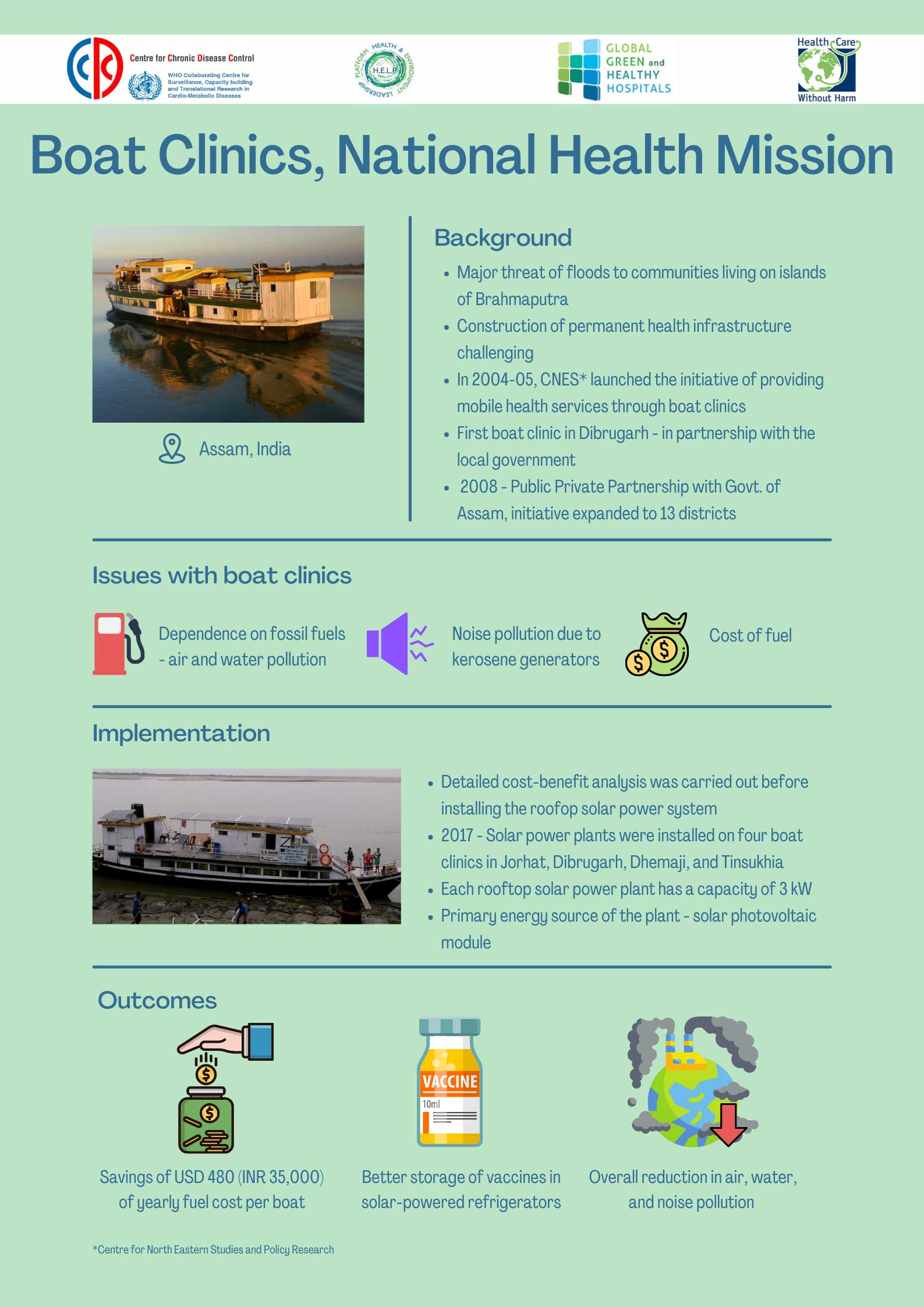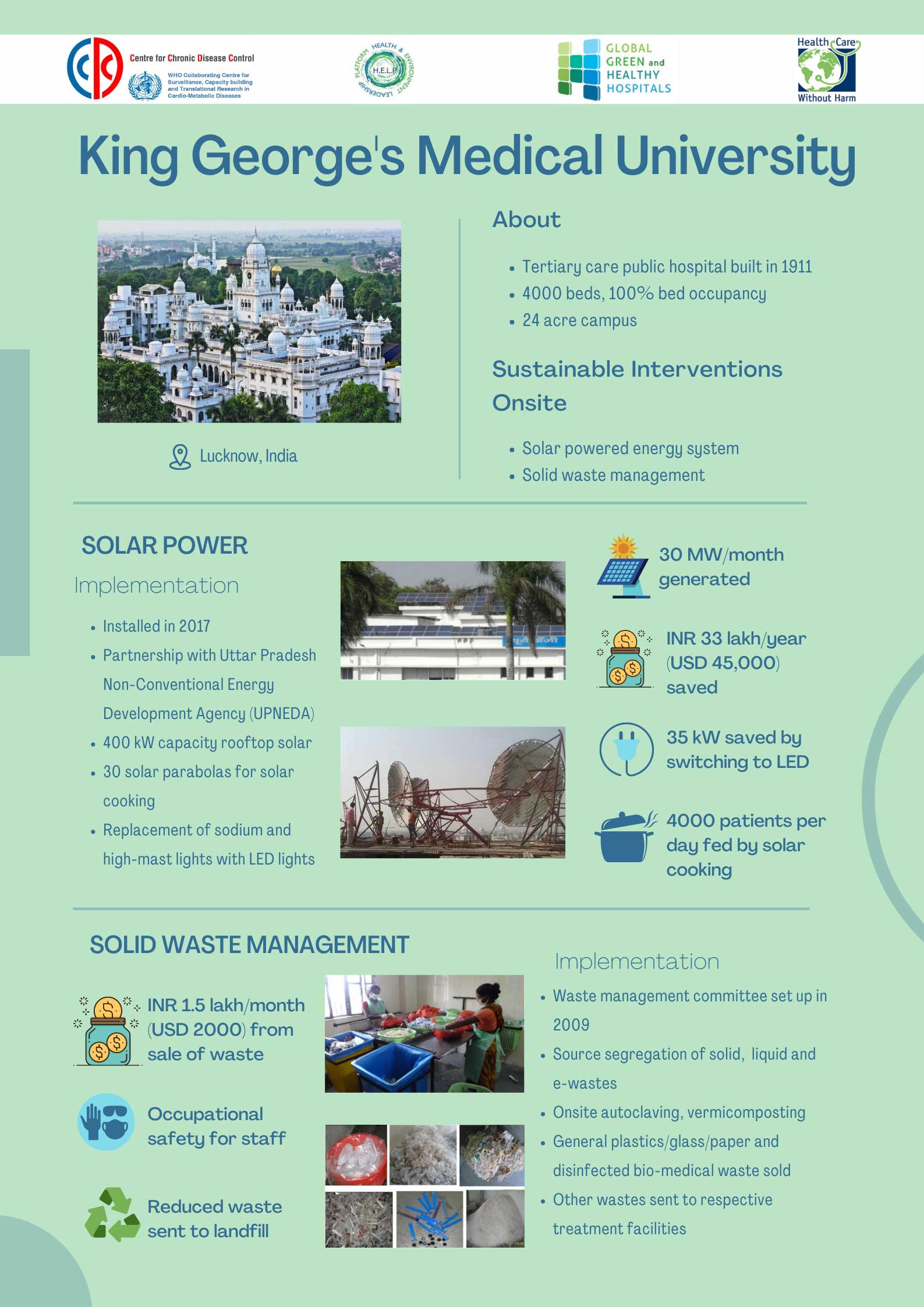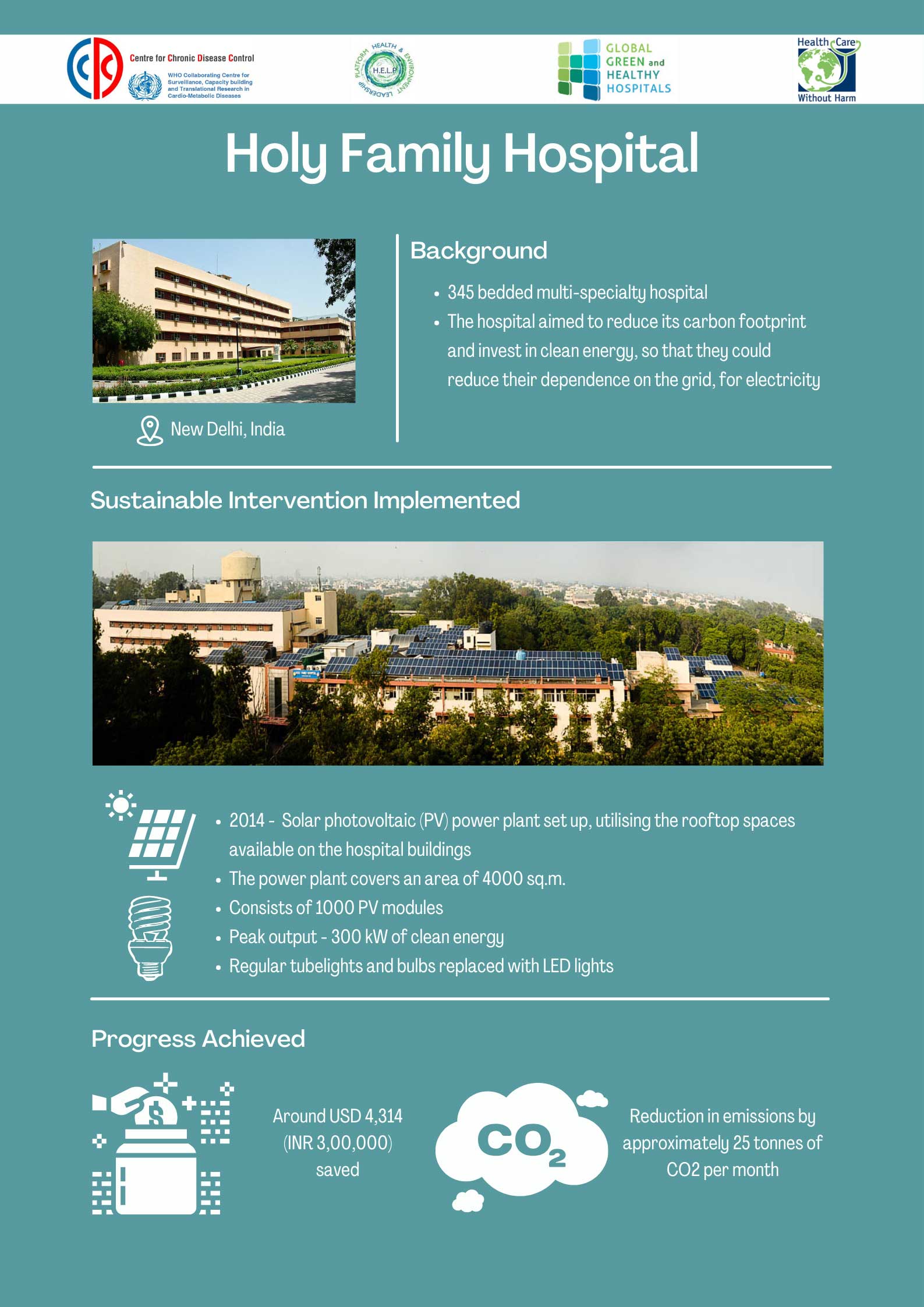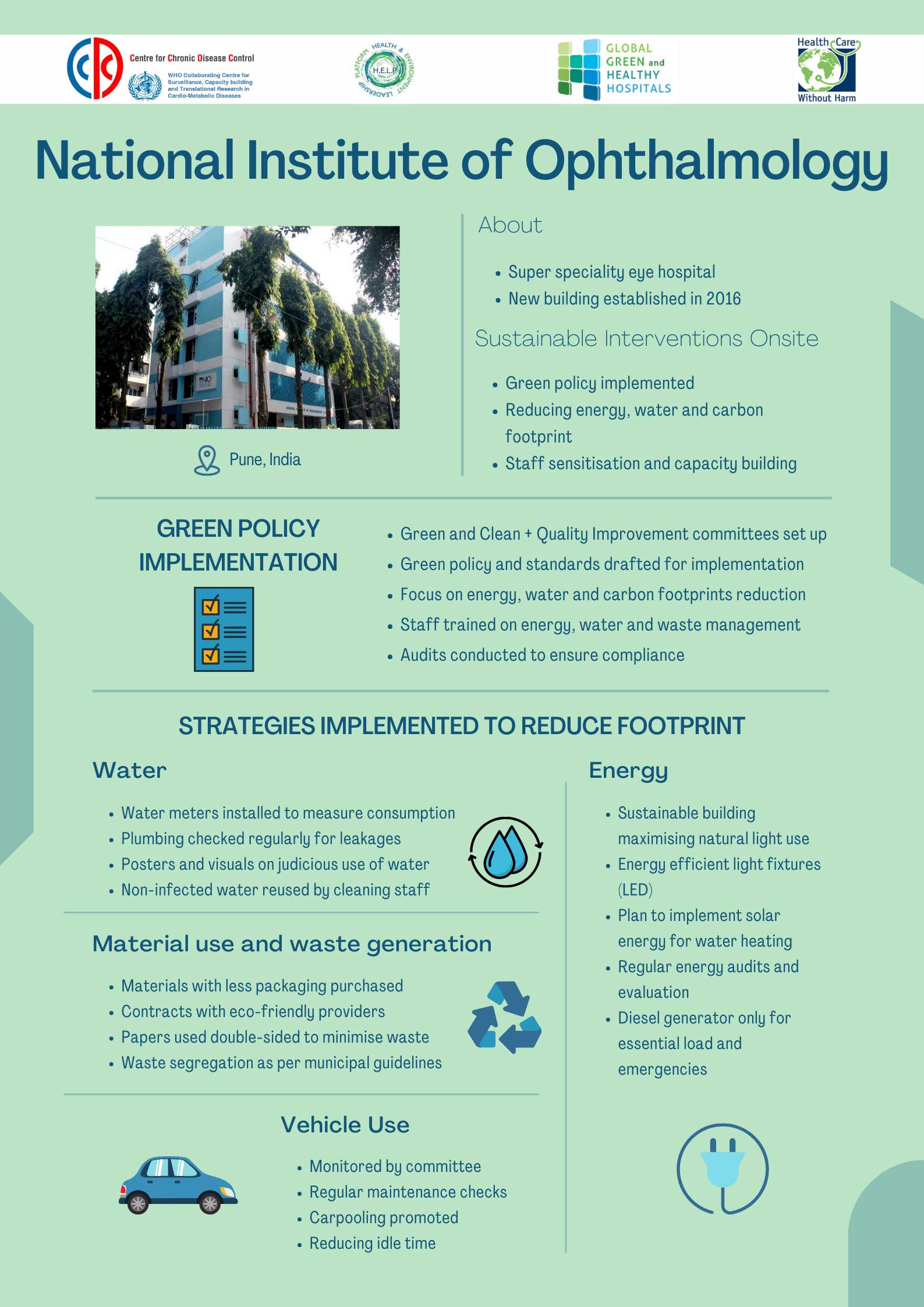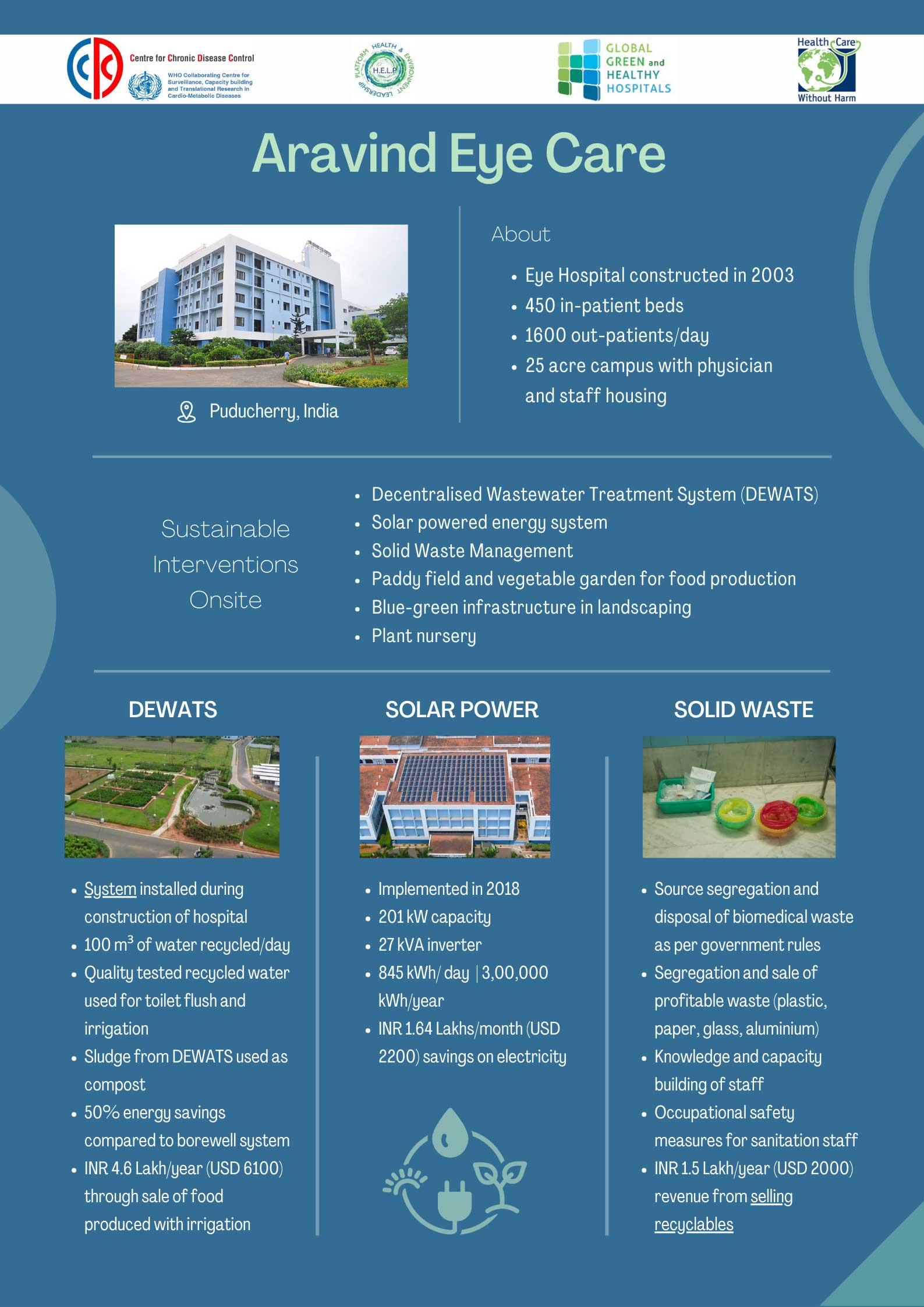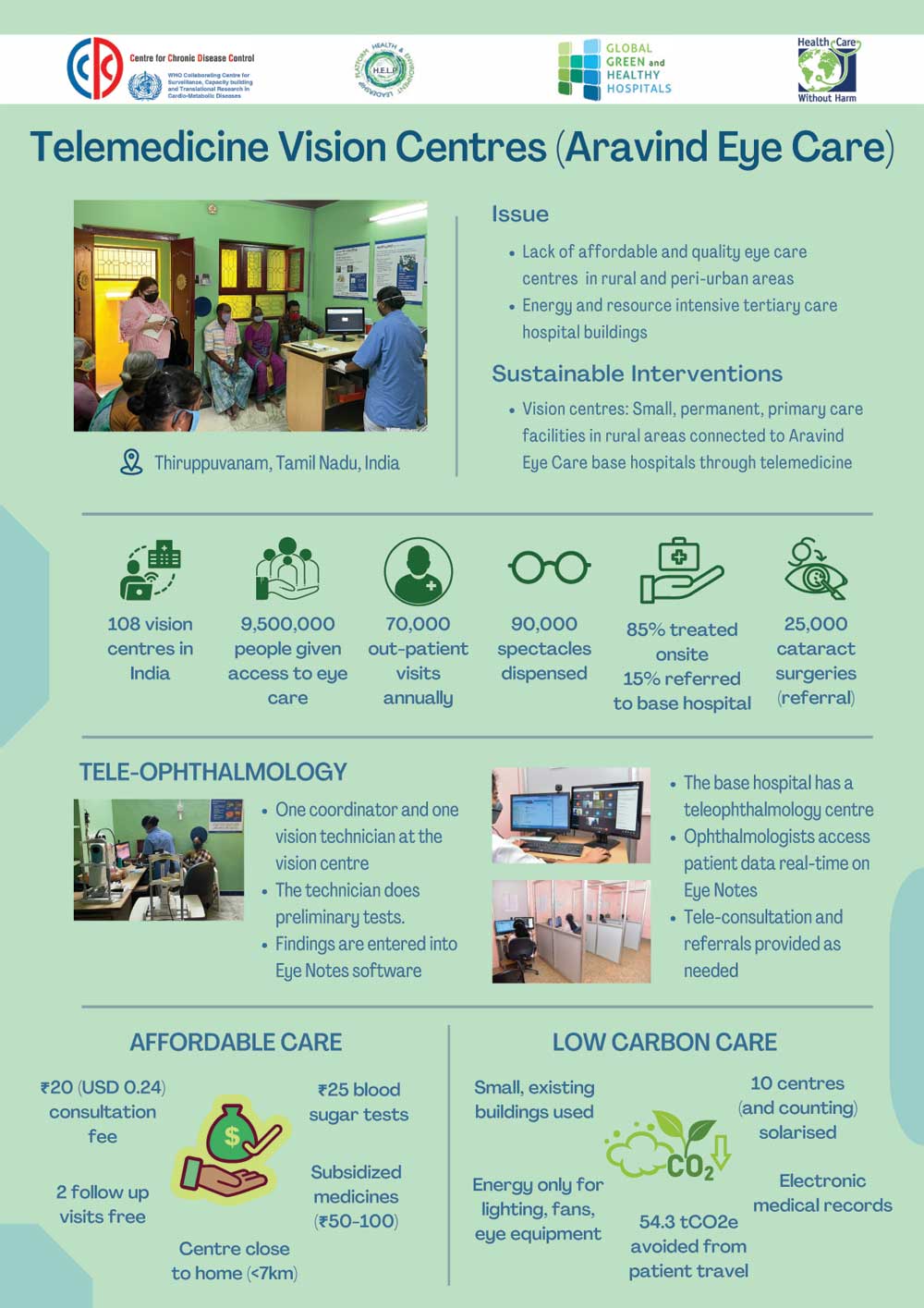Case Studies
Best practices of sustainability in the Indian Health sector
H.E.L.P documents the environmentally positive measures taken by health care facilities / health systems to demonstrate the momentum and scale of low-carbon implementation in Indian health sector.
Vistex Hospital, Bihar
The establishment of Doctors for You (DFY) – Vistex Hospital came out of the need for a healthcare facility in the rural area of Masarhi, Bihar. DFY is an organisation that works in many areas, environment and sustainability being one of them. The idea was to build an energy-efficient hospital which would sustain itself, to avoid the unreliable power supply, often experienced in rural parts of India. The aim was to achieve energy efficiency through a combination of solar energy and green building design.
Boat Clinics of Assam
Approximately six percent of Assam’s land is covered by the islands of Brahmaputra and a total of ten percent population of the state resides in these islands. The islands face the major threat of frequent floods that affect the health status of island communities. The area has few health facilities that are not sufficient to fulfill the requirements of the entire population. Construction of permanent infrastructure to provide health facilities is another challenge due to the recurring floods. The situation is worsened by the fact that people residing in these areas change their base every six months either due to erosion of land or in search of livelihood. Keeping these in view the Centre for Northeastern Studies and Policy Research (C-NES) launched a unique initiative in June 2004-2005, of providing mobile health services through boat clinics to bring better health facilities to the marginalized communities in the Brahmaputra valley. A total of 15 boat clinic units are now operational across 13 districts. To promote sustainable and clean energy-based healthcare services, SELCO foundation installed solar rooftop power plants at 4 of these boat clinics
.
King George’s Medical University, Lucknow
In 2017, KGMU installed an on-campus solar power plant and solar parabolas with the aim to reduce their power cost and ecological footprint under Uttar Pradesh Non-Conventional Energy Development Agency (UPNEDA). Management team and the team at University Environment Department of KGMU has a clear vision of making the hospital campus energy efficient aiming to bring down their power cost and carbon footprint. Apart from the energy initiatives, environment division at the campus is also actively involved in plastic recycling and selling out the plastic scrap for financial benefits.
Holy Family Hospital, Delhi
With a clear vision of reducing the energy costs and carbon footprint of the hospital, the management installed solar power plant to reduce dependence on conventional sources and switch to clean energy. The hospital aims to use solar energy to offset a part of its electricity dependence on the utility grid. The initiative is also aimed at reducing the hospital’s carbon footprint. The solar photovoltaic power plant, installed at the hospital in 2014 has panels spread across all building rooftops. Apart from this, the hospital has also installed energy efficient LED lights that use about 50% less electricity than the traditional incandescent, fluorescent and halogen options.
National Institute of Opthalmology Super Speciality Eye Clinic, Pune
National Institute of Opthalmology has taken measures to improve its efficiency in energy, water, and waste. It is the first NABH accredited eye hospital of Pune that adopted Green Policies in 2016 and implemented it in their newly built green building, primarily designed to minimize energy footprint.
HBT Medical College and Dr RN Cooper Municipal General Hospital, Mumbai
HBT Medical College and Dr RN Cooper hospital is a major municipal general hospital located in the western suburbs of Mumbai. The hospital was established in 1969 and upgraded into a medical college in August 2015. It is a 636 bedded secondary care hospital with all general specialties. The municipal general hospital has installed a solar water heating system with a capacity of 3000 L per day (each) at 6 buildings within the hospital campus to reduce its dependence on grid-based electricity and to gradually switch to sustainable energy.
Food waste that ends up in landfills produces a large amount of methane – a more powerful greenhouse gas than CO2. Brihanmumbai Municipal Corporation (BMC)’s Environment Status Report observes that out of the 9,400 tonnes of waste that is sent daily to Mumbai’s dumping grounds, 73% comprises food, vegetable, and fruit wastes. The Solid Waste Management Rules 2016 makes it mandatory for the bulk waste generators to manage and treat their solid waste at the site of waste generation. Considering the above, HBT Medical college and Dr. RN Cooper Hospital, a municipal general hospital undertook vermi-composting to treat its dry food waste. Dry food waste is one of the components of the total solid waste generated at the hospital which includes wet food waste and biomedical waste as among the other components. Biomedical waste is segregated as per the law at hospital campus and is sent to a non-profit for further treatment and disposal. Wet food waste is also sent to another non-profit for the treatment and disposal.
Bhagat Chandra Hospital, New Delhi- India
The management of Bhagat Chandra hospital wanted to reduce their carbon footprint and invest in clean energy; implementing this will have both environmental and economic benefits. The proposal to exchange all the compact fluorescent lamps (CFLs) and bulbs for light emitting diodes (LED) lamps was first proposed in 2014. After witnessing economic benefits from this initiative, the management decided to install 20kW of Solar plant in December 2015 and added 30kW more in September 2016 to further improve their initiative on reducing carbon footprint. Besides these, the hospital has adopted many initiatives to improve energy efficiency of the building.
Aravind Eye Care, Pondicherry
During the construction of the hospital in 2003, it was then decided to install a water recycling system, which will help reduce waste, and water consumption. But instead of opting for a conventional centralized treatment plant, the hospital management installed a decentralized wastewater treatment system called the DEWATS which usually functions without technical energy input. They are based on a modular, technical configuration concept which lets the user pick combinations of treatment modules depending on the required treatment efficiency, costs, land availability, etc and are constructed from locally available materials. DEWATS require only a few maintenance support like yearly sludge removal, filter bed cleaning, etc. DEWATS can reduce pollution load to fit legal requirements.
After the Ministry of Environment, Forest and Climate Change of India released the Bio-Medical Waste Management Rules, it is now a legal requirement to safely dispose bio-medical waste. Realising that proper bio-medical waste segregation is the key to efficient waste management, the hospital formed a waste management team and sensitised its medical and non-medical staff, trained them on the difference between normal waste and bio-medical waste. Employees handling waste were given proper awareness on bio-medical waste and safe disposal of waste. The waste generated and disposed was recorded, this helped them understand different types of waste. The reusable materials were resold creating revenue from this model.
Family Health Centre, Noolpuzha, Kerala
Noolpuzha FHC, under the leadership of Dr Dahar Mohammed, has been very proactive in providing primary health services to residents of Noolpuzha (a village in Wayand district of Kerala). The decentralised planning in Kerala makes it possible for primary level health officers to be able to drive decisions that help in making healthcare services accessible. The FHC has implemented a number of green initiatives such as digital health services, use of solar energy for water heating and outer lighting, rainwater harvesting, composting, segregation of biomedical waste, e-auto for patient transportation.
Reducing Carbon footprint through assisted telemedicine services by Aravind Eye Care
Aravind eye care in Tamil Nadu, India has set up satellite telemedicine services in per-urban areas to provide access to primary eye care in regions without any prior eye care services. This service provides subsidised care that prevents needless blindness in these regions, as well as prevents patient travel to far off tertiary care eye hospitals. This reduction in travel has avoided 54.3 tCO2e of carbon emissions from patient travel in the year 2021.
Dry Waste Management in Sri Sathya Sai Institute of Higher Medical Sciences, Bangalore
Sri Sathya Sai Institute of Higher Medical Sciences (SSSIHMS) (Bangalore, India) is a 100% charitable, 333 bedded tertiary care facility. The campus is spread over 52.23 acres of land consisting of main hospital building, residential quarters, canteens, dormitories etc. Since 2021, the campus has taken an initiative to manage their waste sustainably. Initiatives include sensitisation of staff, setting up a waste management committee source segregation, sale of recyclables to specific vendors (revenue of ₹ 9.5 lacks between Jan 21 – Oct 22).
Williamnagar Civil Hospital, Meghalaya
In 2020, when COVID-19 cases were on the rise, Williamnagar Civil Hospital was converted into a Covid care centre. The blocks that were used as a Covid care centre and isolation ward were installed with solar panels that power basic loads like lighting as well as critical equipment for covid care. The use of solar energy has resulted in savings of up to Rs 97,000/USD 1,246 on yearly diesel expenditure (assuming a diesel generator would have been used as a power backup option) and prevention of 5.11 tons of carbon emissions per year as well. The hospital has a vermicomposting pit, about 4×6 feet, wherein food waste from kitchen and patient wards is dumped. The manure that is generated is used for plants and trees on the hospital premises. They also have a setup for rainwater harvesting. The collected water is used for laundry and gardening.
Lokmanya Tilak Municipal General Hospital
Lokmanya Tilak Municipal General Hospital (LMTMG), commonly known as ‘Sion Hospital’ adopted on-site treatment of their food waste through aerobic bacterial composting. The hospital took a step further by treating both its dry and wet food waste, thereby reducing a major chunk of solid waste load on the municipal waste dump site. Food waste is one of the major components of the solid waste that usually is sent to the municipal dump sites. Biomedical waste, being among the other solid waste generated at the hospitals, is segregated and disposed of as per the Biomedical Waste Management Rules at LMTMG hospital.
Meghalaya Sub-centres
The government of Meghalaya, in partnership with SELCO Foundation, under National Health Mission has installed solar panels on 100 sub-centres in eleven districts, along with energy efficient equipment. The list of equipment that runs on solar energy includes – tube lights, fans, charging points, radiant warmer, suction apparatus, spotlight, and vaccine refrigerator.


